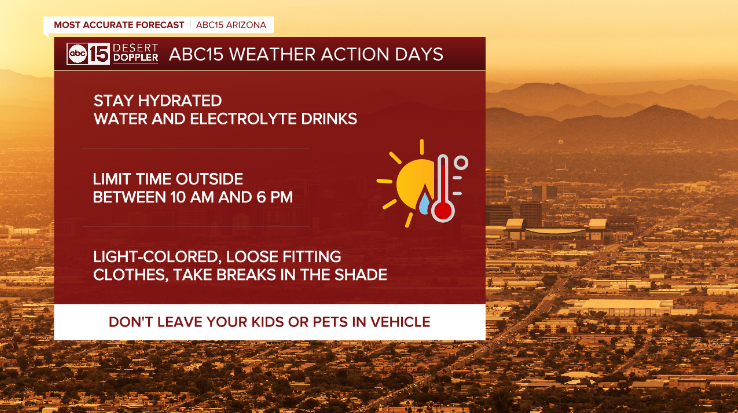The Reasons Behind Missing Excessive Heat Warnings In Forecasts

Table of Contents
Limitations in Current Forecasting Technology
Accurately predicting extreme heat events is a significant challenge for meteorologists. While forecasting technologies have advanced, several factors limit their precision in predicting the intensity and location of excessive heat. The influence of local geography plays a crucial role; mountainous regions experience different heating patterns than flatlands, and coastal areas benefit from moderating sea breezes. Urban heat island effects, where cities retain significantly more heat than surrounding areas, further complicate predictions. Microclimates, characterized by small-scale variations in temperature and humidity, add another layer of complexity.
- Difficulty in modeling complex interactions: Accurately predicting extreme heat requires modeling the intricate interplay between atmospheric pressure, humidity, wind speed, and solar radiation. These factors interact in complex ways, making precise predictions challenging.
- Inaccurate readings from sparsely located weather stations: Many rural areas lack sufficient weather monitoring stations. This sparse data coverage leads to less accurate models and less precise heat wave predictions. The limited spatial resolution restricts the ability to pinpoint hyperlocal heat pockets.
- Limitations of current computational power: Predicting extreme heat accurately requires processing vast datasets containing information from various sources. Current computational power sometimes struggles to handle the sheer volume of data needed for highly accurate, hyperlocal predictions, especially for rapidly developing heat waves.
The concept of lead time is critical for effective warnings. Lead time refers to the period between the issuance of a warning and the onset of the extreme heat event. Providing sufficient lead time allows individuals and communities to prepare and take protective measures. However, predicting the precise timing and intensity of fast-developing heat waves remains a significant challenge, often reducing effective lead time.
Data Collection and Accessibility
Accurate forecasting hinges on robust data collection. Gaps in data acquisition, particularly in low-income or underserved communities, represent a significant obstacle to effective Excessive Heat Warnings.
- Insufficient number of weather monitoring stations: A lack of weather stations, especially in rural and sparsely populated areas, leads to inadequate data coverage. This limits the resolution of weather models and reduces the accuracy of heat wave predictions.
- Lack of real-time data from personal weather stations and citizen science initiatives: Integrating data from personal weather stations and citizen science projects could significantly improve the granularity and accuracy of forecasting models. However, systematic incorporation of this data remains underdeveloped.
- Uneven distribution of resources for data processing and analysis: Unequal access to resources for data processing and analysis creates disparities in forecasting capabilities. Some areas may lack the technological infrastructure or expertise to effectively analyze available data, hindering the accuracy of predictions.
Improving data collection and accessibility is paramount to enhancing the accuracy of Excessive Heat Warnings. This includes investing in additional weather monitoring stations in underserved areas, promoting citizen science initiatives, and ensuring equitable access to data processing and analytical tools. The incorporation of real-time data from various sources can paint a more complete picture of heat patterns, facilitating more timely and accurate warnings.
Communication and Dissemination of Warnings
Effective communication strategies are essential for disseminating Excessive Heat Warnings to the public. However, several challenges hinder the effective reach of these warnings.
- Challenges in reaching vulnerable populations: Reaching vulnerable populations, including the elderly, low-income individuals, and those with limited access to technology, presents a significant communication challenge. These groups may not have access to the necessary information or the means to act on the warnings.
- Need for clear, concise, and culturally sensitive messaging: Warnings must be clear, concise, and easy to understand for all individuals, regardless of their background or literacy level. Culturally sensitive messaging is crucial to ensuring that the warnings are effectively communicated and acted upon.
- Importance of utilizing diverse communication channels: Utilizing diverse communication channels—including social media, radio, television, text alerts, community outreach programs, and partnerships with local leaders—is critical to reaching a wider audience.
Multi-lingual communication strategies are also essential in diverse communities. Collaboration with community leaders and organizations can help tailor warnings to specific cultural contexts and ensure that they reach those most at risk.
Underestimation of Heat's Severity
Society often underestimates the dangers of extreme heat compared to other weather events like hurricanes or blizzards. Heat is a silent killer, claiming more lives annually than many other weather-related events.
- Heat is a silent killer: Unlike other weather events with visible cues, heat’s danger is less apparent. This leads to complacency and a lack of preparedness.
- Lack of public awareness: Many individuals are unaware of the symptoms of heat-related illnesses and the preventative measures they can take to protect themselves.
- The need for educational campaigns: Public awareness campaigns are crucial to educate individuals about the risks of extreme heat and provide them with the knowledge and resources needed to stay safe.
Conclusion
The absence of sufficient Excessive Heat Warnings is a critical public safety issue. Improving forecasting accuracy requires advancements in weather modeling technology, enhanced data collection networks, and more effective dissemination strategies. Addressing data gaps, particularly in vulnerable communities, is crucial. By investing in improved technology, optimizing data collection and communication practices, and raising public awareness about heat-related risks, we can significantly reduce the number of missing and insufficient Excessive Heat Warnings and ultimately save lives. Let's work together to improve excessive heat warning systems and build more resilient communities.

Featured Posts
-
 Dara O Briains Voice Of Reason Dissecting Current Events With Wit
May 30, 2025
Dara O Briains Voice Of Reason Dissecting Current Events With Wit
May 30, 2025 -
 Djokovic And Norrie At Roland Garros Upsets And Easy Wins
May 30, 2025
Djokovic And Norrie At Roland Garros Upsets And Easy Wins
May 30, 2025 -
 Guide Des Droits De Douane Declaration Et Procedures Simplifiees
May 30, 2025
Guide Des Droits De Douane Declaration Et Procedures Simplifiees
May 30, 2025 -
 Mongoliya Massovaya Vaktsinatsiya V Otvet Na Epidemiyu Kori
May 30, 2025
Mongoliya Massovaya Vaktsinatsiya V Otvet Na Epidemiyu Kori
May 30, 2025 -
 Grand Est Polemique Autour Des Subventions Pour Un Concert De Medine
May 30, 2025
Grand Est Polemique Autour Des Subventions Pour Un Concert De Medine
May 30, 2025
Latest Posts
-
 Grigor Dimitrov Vliyanieto Na Kontuziyata Vrkhu Karierata Mu
May 31, 2025
Grigor Dimitrov Vliyanieto Na Kontuziyata Vrkhu Karierata Mu
May 31, 2025 -
 Kontuziyata Na Grigor Dimitrov Aktualna Informatsiya I Analiz
May 31, 2025
Kontuziyata Na Grigor Dimitrov Aktualna Informatsiya I Analiz
May 31, 2025 -
 Trumps Uncertainty What Made Him Question Elon Musk
May 31, 2025
Trumps Uncertainty What Made Him Question Elon Musk
May 31, 2025 -
 Uncertainty And The End Trumps Doubts About Elon Before The Break
May 31, 2025
Uncertainty And The End Trumps Doubts About Elon Before The Break
May 31, 2025 -
 Everything Revealed In The Star Trek Strange New Worlds Season 3 Teaser
May 31, 2025
Everything Revealed In The Star Trek Strange New Worlds Season 3 Teaser
May 31, 2025
